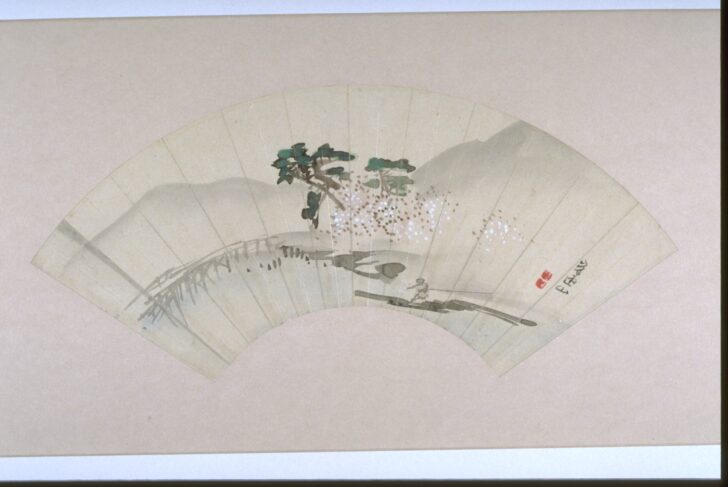Spring blossoms at Arashiyama
Kishi Renzan

Description
Originally a folk ritual to entertain the god of rice who descends from mountains every spring, cherry blossom viewing (hanami) had become by the early medieval period the favorite spring event in Japan. People of all social classes, from wealthy warlords to ordinary townsmen, set out for hours of picnicking and partying under billowing clouds of cherry blossoms in full bloom.
One of the famous places for cherry blossom viewing in Kyoto was (and still is) Arashiyama, or “Storm Hill,” on the far bank of the Katsura River in the northwestern quarter of the city. The site was so well known as a tourist destination that Kishi Renzan, an artist of the popular Kishi studio in Kyoto, could evoke the scene with only a few brush strokes.
Maribeth Graybill
“Four Seasons In Japanese Art”: Special Installation of Japanese Gallery at UMMA: Object Labels
July 5, 2003-January 4, 2004
Subject Matter:
Originally a folk ritual to entertain the god of rice who descends from mountains every spring, cherry blossom viewing (hanami) had become by the early medieval period the favorite spring event in Japan. People of all social classes, from wealthy warlords to ordinary townsmen, set out for hours of picnicking and partying under billowing clouds of cherry blossoms in full bloom.
One of the famous places for cherry blossom viewing in Kyoto was (and still is) Arashiyama, or “Storm Hill,” on the far bank of the Katsura River in the northwestern quarter of the city. The site was so well known as a tourist destination that Kishi Renzan, an artist of the popular Kishi studio in Kyoto, could evoke the scene with only a few brush strokes.
Maribeth Graybill
“Four Seasons In Japanese Art”: Special Installation of Japanese Gallery at UMMA: Object Labels
July 5, 2003-January 4, 2004
"Japanese art has a rich tradition in the depiction of flora and fauna. Until the 17th century powerful and myth-like creatures such as dragons, phoenixes, lion dogs, birds of prey and tigers were portrayed as aggressive. This changed however when the influence of the samurai subsided and urban culture began to develop. Rich merchants sought refinement and a sympathetic style and in the artistic rendition of nature docile animals in subtle well-balanced compositions emerged. Flowers and birds became popular subjects, not only for their esthetic beauty but for their symbolic significance as well.
The literal meaning of the Japanese word kachō-ga is ‘images of flowers and birds’. Richly coloured flowers and birds are the focal point of this exhibition that illustrates the origin and development of this decorative genre. Colourful plants and animals embellish the screens, scrolls, albums, illustrated books, fan-shaped prints and graphs dating back to the 18th and 20th century."
"Kachō-Ga. The Poetry of Japanese Nature.” Sieboldhuis, 13 Feb. 2019, www.sieboldhuis.org/en/exhibitions/kachōga-de-poëzie-van-de-japanse-natuur.
Physical Description:
There is a tree on a fan paining with spring blossoms flowing from it. There is a person standing in front of the tree and grass surrounding the tree. On the right side of the painting, there is a signature and two seals.
Usage Rights:
If you are interested in using an image for a publication, please visit https://umma.umich.edu/request-image/ for more information and to fill out the online Image Rights and Reproductions Request Form.